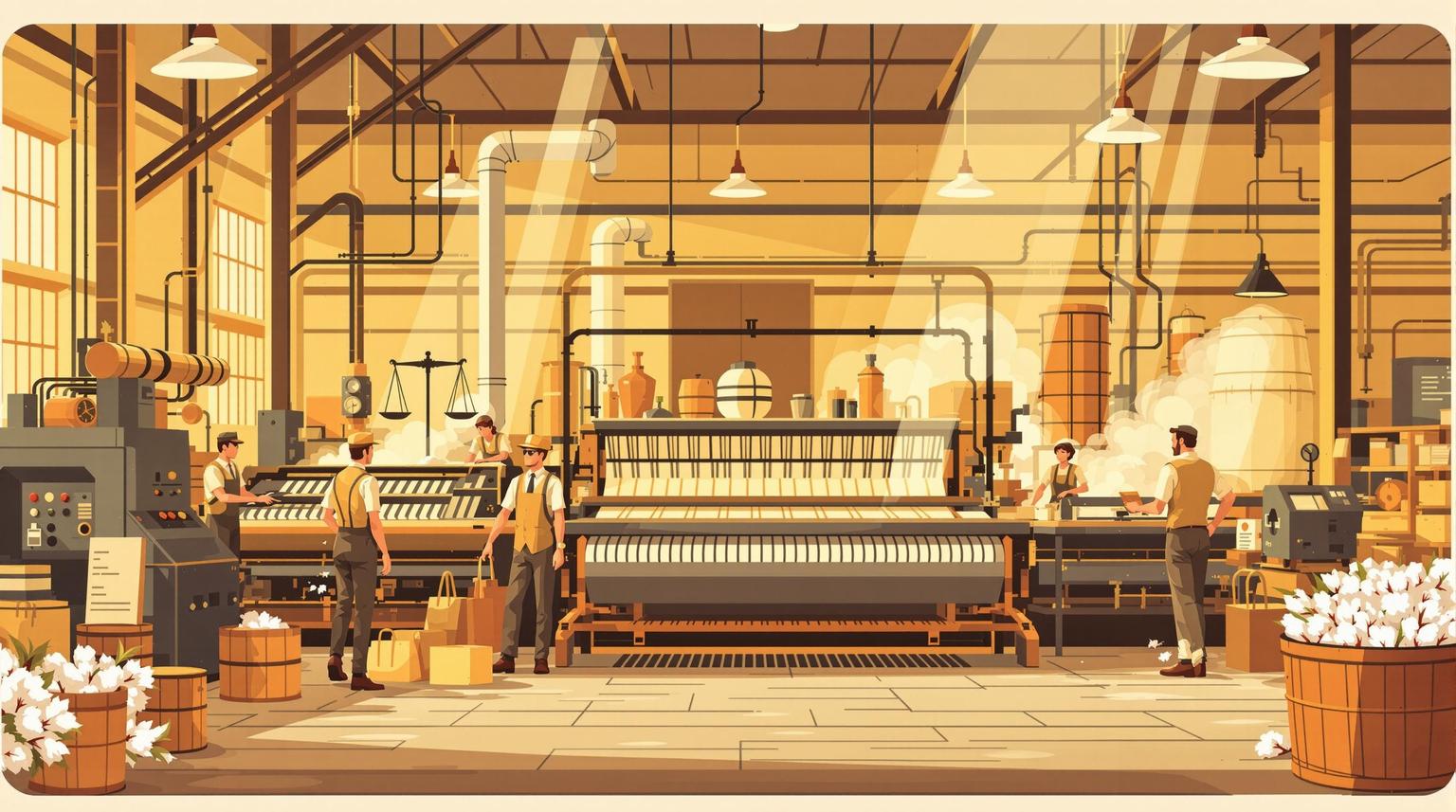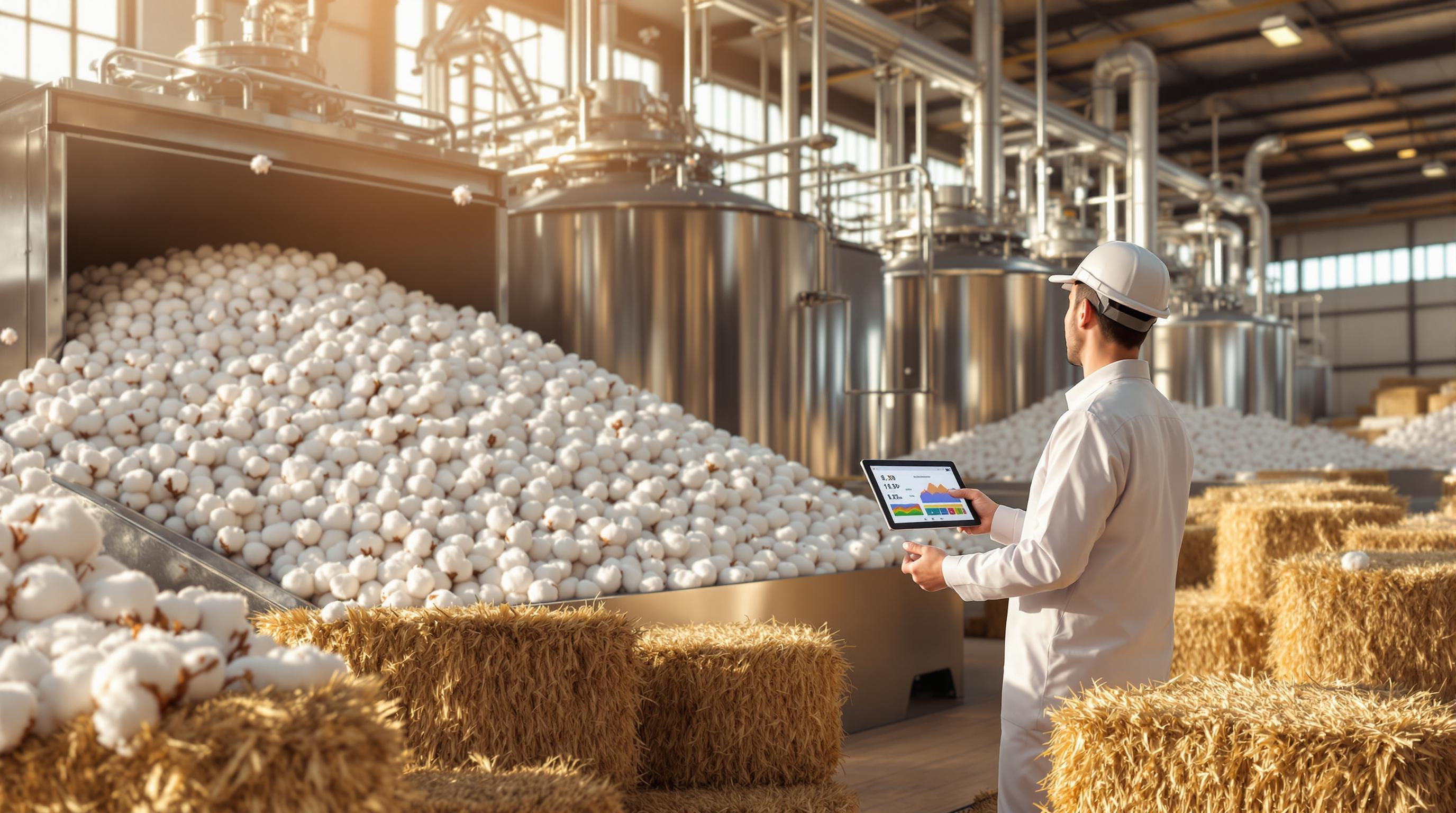AI is transforming cotton ginning by increasing efficiency, improving cotton quality, and reducing waste. Here's how:
- Quality Control: Machine learning and vision systems detect impurities like plastic and adjust cleaning processes in real-time, preserving fiber quality and minimizing waste.
- Automation: AI-powered robotics handle tasks like feeding, seed removal, and packaging, ensuring consistency and safety while reducing manual labor.
- Predictive Maintenance: Smart sensors monitor equipment performance, enabling proactive repairs and reducing downtime.
- Economic and Environmental Benefits: AI systems lower costs by improving efficiency by up to 30% and reducing resource usage.
Despite challenges like high costs and the need for skilled workers, AI adoption is setting a new standard for cotton ginning, making processes faster, smarter, and more efficient.
Exploring New Cotton Gin Technology at White Oak Gin in Missouri

AI Tools Transforming Cotton Gin Operations
Today's cotton ginning operations are undergoing a major transformation thanks to AI tools that boost efficiency, improve quality control, and streamline maintenance. These advancements are turning traditional processes into data-driven, high-tech systems.
Machine Learning in Quality Control
Machine learning is reshaping quality control by enabling real-time detection and correction of defects. Advanced machine vision technology can analyze up to 110,000 square inches of cotton per bale at an impressive 60 frames per second [2]. These systems evaluate fiber characteristics, identify impurities, and adjust cleaning settings to maintain consistent quality while reducing fiber waste.
While machine learning focuses on quality, AI-powered robotics are making operations smoother and safer.
AI-Powered Robotic Automation
AI-driven robotics handle essential tasks such as feeding cotton, removing seeds, and packaging bales. These automated systems ensure uniform quality, minimize errors, and enhance workplace safety. By automating repetitive tasks, they help maintain high operational standards and free up human workers for other responsibilities.
AI doesn’t stop at automation - it also plays a big role in keeping equipment running efficiently.
Predictive Maintenance with AI
Smart sensors track equipment performance in real time, feeding data into predictive algorithms. This allows cotton gins to anticipate potential failures, schedule maintenance at the right time, and cut down on costly downtime.
"The integration of AI with Industry 4.0 technologies, such as the Internet of Things (IoT), enables smart manufacturing and greater visibility and control over the entire cotton processing chain. This connectivity allows for seamless integration into larger production networks, optimizing logistics and reducing the risk of supply chain disruptions" [1].
AI tools are reshaping cotton ginning by making processes faster, smarter, and more efficient than ever before. These technologies are not just improving operations - they’re setting a new standard for the industry.
sbb-itb-0e617ca
Adopting AI and Its Measurable Results
AI in Cotton Ginning: Real-World Applications
AI has brought noticeable advancements to cotton ginning, particularly in efficiency and quality control. High-speed machine vision systems now analyze cotton lint in real-time, allowing immediate adjustments during cleaning. This helps preserve fiber quality while reducing unnecessary damage [2].
Another breakthrough involves AI-powered vision systems that accurately detect and remove plastic contaminants. By maintaining consistent cotton quality during processing, these systems have redefined quality control standards across the industry.
Economic and Environmental Impact
The adoption of AI in cotton ginning has led to measurable economic gains and reduced environmental impact. For example, machine vision systems have improved efficiency by up to 30% by monitoring trash content in real-time. This has lowered operational costs and minimized waste [2].
| Category | Impact |
|---|---|
| Better Cotton Quality | Higher-grade cotton due to effective contamination control and fiber care |
| Reduced Resource Usage | Optimized energy use and less fiber waste |
| Improved Maintenance | Predictive systems reduce downtime |
| Increased Productivity | Automation boosts inspection and overall output |
"The integration of AI and machine vision in cotton ginning is becoming more prevalent, with systems capable of detecting and removing plastic contamination and improving cotton quality" [3].
These advancements highlight AI's ability to reshape cotton ginning processes, though challenges still lie ahead as the industry continues to evolve.
Future of AI in Cotton Ginning and Challenges
New AI Technologies in Cotton Ginning
AI is transforming cotton ginning by introducing smarter processes through robotics and supply chain tools. These advancements are already showing results, like better cotton quality and less waste.
AI-powered robotics handle tasks like feeding, seed removal, and packing with precision, ensuring consistent results. On the supply chain side, AI helps manage inventory, predict demand, and improve logistics.
| AI Technology | Primary Function | Expected Impact |
|---|---|---|
| Smart Sensors | Real-time monitoring | Adjust cleaning dynamically |
| IoT Integration | Communication across systems | Better process visibility |
| Robotic Systems | Automated processing | Less reliance on manual work |
| Supply Chain AI | Optimizing logistics | Faster, more efficient delivery |
These tools are paving the way for more efficient operations, but they also come with their own set of challenges.
Barriers to AI Adoption
Adopting AI in cotton ginning isn't simple. The main challenges include high costs, the need for skilled workers, and facility upgrades. Smaller gins, in particular, struggle with the significant upfront investment required to implement these systems.
There’s also a lack of workers trained in AI, robotics, and data analysis. To address this, partnerships with educational institutions are helping create training programs tailored to the industry’s needs.
Additionally, many facilities need upgrades to handle AI systems, such as better network infrastructure, advanced sensors, and updated control systems for real-time data use.
Solving these issues will require affordable AI tools and accessible training, especially for the smaller operations that play a critical role in the cotton ginning industry.
Conclusion and Final Thoughts
AI's Impact on Cotton Ginning
AI technologies are reshaping how cotton ginning operations work. Tools like advanced machine vision, predictive maintenance, and automated systems are making processes more efficient. These technologies improve communication across systems, giving operators greater control and visibility over the entire cotton processing chain [1]. With real-time monitoring and interconnected networks, efficiency has increased by up to 30%, while waste and downtime have been significantly reduced [2].
A Call to Action for Industry Leaders
For cotton gin operators aiming to stay competitive, adopting AI is no longer optional. While the upfront investment might seem steep, the long-term gains - like cutting operational costs and boosting productivity - make it a smart move.
By focusing on workforce training, upgrading infrastructure, and gradually integrating AI tools, operators can see meaningful improvements in efficiency and product quality within two years. For those looking to connect with peers or explore facilities already using these advancements, platforms like cottongins.org offer valuable networking and detailed directories of cotton gin operations across the U.S.
AI is redefining the cotton ginning landscape. Its ability to improve efficiency, cut waste, and support more sustainable practices positions it as a critical step forward for the industry. Though challenges exist, the long-term rewards make the journey worth it, setting the stage for a stronger, more competitive future.


